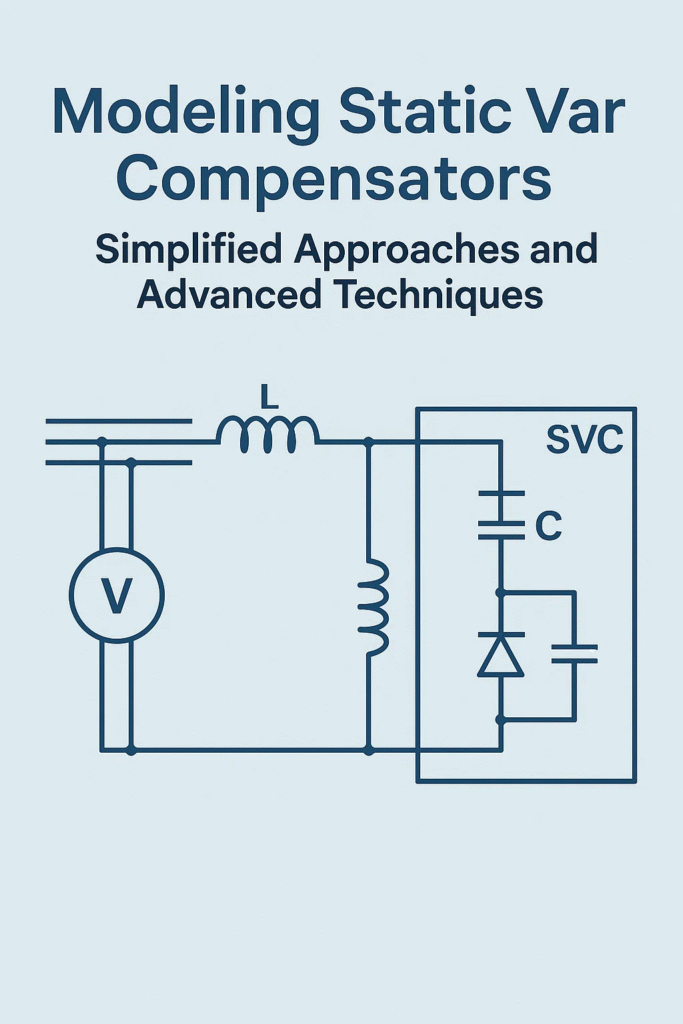🔌 Introduction
Electric power systems resemble fragile ecosystems — even a minor imbalance can throw everything into chaos. A highly covert instigator? Variations in voltage. Introducing the Static Var Compensator (SVC): a strong answer to this seemingly straight forward but intricate problem. Although it resembles a concept from a science fiction book, the SVC is indeed real and is crucial to contemporary power grids. This article will walk you through the basics and explore the advanced modeling methods employed to enhance its performance
🌐 What Is a Static Var Compensator?
A Static Var Compensator belongs to the Flexible AC Transmission System (FACTS) category. It fundamentally acts as a voltage stabilizer, dynamically and rapidly managing reactive power to ensure consistent voltage levels.
Essential Characteristics:
– Quick reaction to fluctuations in voltage
– Improved grid reliability and electricity quality
– No parts that rotate(thus “static”)
Frequent Uses:
– Transmission networks for high voltage
– Factories with varying electricity requirements
– Systems for integrating renewable energy
🧩 The Building Blocks of SVCs
Let’s break it down into bite-sized technical pieces:
| Component | Function |
|---|---|
| Thyristor Controlled Reactor (TCR) | Absorbs reactive power |
| Thyristor Switched Capacitor (TSC) | Provides reactive power |
| Filters | Reduces harmonics and improves waveform |
| Control System | Real-time monitoring and regulation |
Together, these components interact dynamically based on the grid’s needs.
🔄 Streamlined Modeling Techniques
Simplified models are a god send for new comers and rapid feasibility assessments. They sacrifice accuracy for rapidity and lucidity — ideal for initial planning stages.
– Hypothesis: Reactive power varies in direct proportion to voltage.
– Advantages: Simple to integrate into programs such as MATLAB/Simulink.
-Constraint: Fails to account for switching behavior or dynamic latencies.
– Premise: SVC functions in distinct phases.
– Application: Conventional load flow analysis
-Constraint: Excludes rapid transients and thyristor behavior.
These models excel in conceptual design, educational use, and budget-friendly simulations
🔍 Digging Into Advanced Techniques
In actual power systems, accuracy is essential — and that’s where sophisticated modeling comes into play.
1. Dynamic Phasor Models
-Records engagements with other FACTS devices
– Manages rapid and gradual changes in power flow.
– Perfect for analyzing systems with multiple machines
2. State-Space Modeling
- Models the system with differential equations
- Utilized for control design and stability evaluation
- Necessitates rigorous mathematics and precise parameterization
3. EMT (Electromagnetic Transient) Models
- Grounded in time-domain simulation
- Records switching occurrences, harmonics, and fault situations.
- Utilized in software such as PSCAD, EMTP, and DIg SILENT Power Factory
4. Machine Learning–Assisted Modeling
- Employs data-driven techniques to adjust control parameters.
- Provides a flexible response in formed by past operations
- Currently in initial ad option stages but has potential for smart grids
🛠️ Software Tools for SVC Modeling
Contemporary modeling depends significantly on simulation programs. Here’s a brief overview:
| Software | Ideal For |
|---|---|
| MATLAB/Simulink | Quick prototyping and control design |
| PSCAD | EMT simulations and fault analysis |
| DIg SILENT PowerFactory | Large grid modeling and optimization |
| Python (SciPy/PyPower) | Custom modeling and experimentation |

💡 Optimal Strategies & Design Suggestions
When planning to model an SVC, consider these points:
– Consistently verify simplified models against actual data.
– Employ mixed methods: integrate straight forward and intricate strategies.
Sensitivity analysis reveal sobs cured weaknesses.
– Pay attention to harmonics and switching delays—they greatly affect performance.
🔮 Future Directions in SVC Technology
As grids develop, SVC modeling will also progress:
– Neural Network Optimization: Instant data enhancement via AI technology
– Broad-Area Collaboration: SVCs interacting throughout the grid for coordinated management.
– Merging with Renewable Sources: Particularly essential since solar and wind generate fluctuating reactive needs.
✅ Conclusion
Static Var Compensators might not be the most striking elements in a power system, yet their function is unquestionably essential. From smoothing out voltage inconsistencies to enhancing the uninterrupted transfer of electricity through contemporary grids, SVCs are the quiet guardians maintaining equilibrium. Basic models serve as the starting point; sophisticated methods reveal deeper insights and expose weaknesses that only detailed simulations can identify.
As the energy paradigm changes — adopting decentralization, renewable sources, and intelligent technology — SVC modeling needs to adapt as well. Combining established engineering practices with new advancements such as AI and machine learning, the future of voltage regulation is not merely reactive it’s anticipatory, foresighted, and profoundly intelligent.
